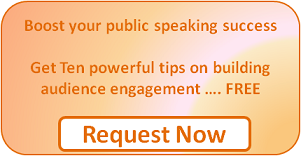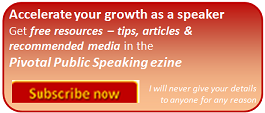|
Articles on
Preparing your Presentation

Improve Your Public Speaking -
4 Tips for Using Evidence
Many tools can be implemented for success in
delivering your speech, whether you are giving a speech to a
public audience, talking with members of a company board
meeting, or simply offering a sales presentation. Such tools
comprise explaining detailed examples, designing statistical
charts, in addition to providing influencing testimony. Below,
we will add another public speaking skill to the list and
explain four special tips for using “evidence” in a influential
speech.
Great Openings.
Use a Pertinent Activity
Using a pertinent activity
as an opening gets the audience's attention
because it makes them active. It gives them the
opportunity to move physically which makes them
more alert and comfortable. It lets them learn
and participate with one another. Finally, it
put you in charge. That's right, when you cede
temporary authority to your audience you get
larger in their minds.
How can you convert
a seminar to a keynote?
In the speaking world, the media
stars are the keynote speakers. A lot of seminar leaders and
trainers ask me how they can adapt their material to this
intense, high-profile, and often lucrative specialty.
* "The keynote speech comes from the discipline of show business. The seminar
comes from the discipline of teaching." Bill Gove, first president of the
National Speakers Association.
* "With a keynote speech, the presenter is the star. With seminars, the leader
needs to make the audience members the star." Don Thoren, past president
National Speakers Association and long-time seminar leader.
To understand the big difference between keynotes and seminars,
start by appreciating the unique characteristics of each.
Incorporate Humour in your
next Presentation
Some speakers say, “I
could never use humour
in my speech; I just
don’t feel comfortable
with it.” I believe
that anyone can use
humour and that it is a
valuable tool in
speaking. Appropriate
humour relaxes an
audience and makes it
feel more comfortable
with you as the speaker;
humour can bring
attention to the point
you are making; and
humour will help the
audience better remember
your point. It can
break down barriers so
that the audience is
more receptive to your
ideas.
First,
let me make it easy for
you to use humour.
How to be a Great Speaker - Tomorrow
Speaking to a trade or professional group-or to a client's employees-is really quite simple. If you're not a professional speaker and want to become one, or are one and want to do it better, here are some shortcuts in one concise article. (And these rules apply to managers at meetings, executives at conferences, presenters at board meetings, and anyone else seeking to influence an audience.)
My Best Presentation Tricks
Giving presentations can be a complete and utter
thrill. Too bad attending them can be a complete
and utter bore. If you are on the giving side, I
want to offer you up a collection of my best
presentation tricks to date
Handling the Audience in Public Speaking
Audiences Are Your Friend
For the rank amateur to the ignorant professional, audiences create the
same effect no matter how small they are to a speaker. Fear and anxiety.
From a single person to a crowd as big as the fans in the Super Bowl,
speaking in front of a serious listening audience is the true test and
baptism of fire.
Despite this, audiences are predictable. Audiences listen to you because
they want to learn something from the speaker.
Following this logic, the speaker would do well to follow the strategy
of making it informative as well as interesting to listeners to see your
speech through till the end.
Here are some tips on how you can have the audience listen in rapt
attention.
Want to be more persuasive? Preparation is the key
Wake me when
it's over -
A guide to no-nap presentations
It’s 9:30 in the morning and you’ve made it
to the third presentation of today’s marketing meeting.
The presenter is pretty much reading word for word from
a deck of 40 slides, which are mostly densely worded,
bulleted items with an occasional chart or graph thrown
in.
You have no interest in the topic, and to keep from
falling asleep during the next 30 minutes, you are
taking this opportunity to proofread some documents for
a pressing deadline.
You realize you are missing about 75 percent of the
material — but you have all the slides on a handout to
refer to later if necessary. The meeting feels like a
complete waste of time and you have this important
deadline?
Okay, rewind:
Using Stories to Bring Your Audience into
Your World
”...Once upon a time…”
“Let me tell you about the time I spent in
the mountains all night by myself –
unexpectedly…”
If you really want to draw your audience
closer to you, tell a story. It should be a
story about yourself or somebody you know.
Try NOT to repeat a story you’ve heard
elsewhere – even if it is a great story.
It’s still another person’s story, and you
lose something by telling another person’s
story – especially if there’s a chance some
of your audience has heard it before.
|